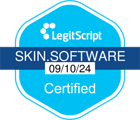When it comes to skincare, not all conditions are treated equally. Acne, eczema, and dry and oily skin can dominate the proverbial conversation, filling shelves at chemists, spas and cosmetics stores alike, and leaving little room for other concerns.
From inflammation to pigmentation, there are many skin conditions that can leave you feeling far from your best though, and when these conditions occupy less room in the conversation, it can leave you feeling more alone than you are.
So, let's take up some space, and talk about a surprisingly common pigmentation disorder known as epidermal melasma.
What is melasma?
Also known as chloasma or a pregnancy mask (for reasons we'll get into shortly), melasma is a skin pigmentation condition that typically affects women with darker skin tones. In simplest terms, it's a physical response where your skin's melanin production increases in response to visible light and UV exposure [1].
It appears as brown or tan patches on the skin usually on the cheeks, forehead, temples, nose or upper lip, and is known for being a stubborn condition to manage [2]. In other words, treating melasma can be complicated and require combination therapy as well as quite a lot of patience.
What causes melasma?
While the exact cause of melasma is unknown, many peer-reviewed studies have found that melasma pigmentation vastly affects more women than men, with some studies finding up to 90% of cases are women [3].
Of those women, pregnant women are even more likely to be affected, with 50-70% of the 90% in the study being pregnant when they developed melasma [3]. That said, pregnancy isn't the only factor creating this sort of facial pigmentation.
Genetics, sun exposure, darker skin types, and hormonal factors — including changes to a woman's birth control pills — can all contribute to developing melasma [1].
What does melasma look like?
Usually appearing on the face, particularly along the upper lip, cheeks, forehead and temples, melasma appears as a disruption to even-toned skin.
Sometimes it can appear as large freckles, but otherwise often shows up in tan or brown pigmentation in the direct aftermath of light exposure.
What is the best treatment for melasma?
Unfortunately, there's no cure for this sort of dermal melasma, but luckily, there are many ways to treat melasma that can help you to take control of your skin tone and feel confident in yourself.
Melasma treatment can be separated into many different categories:
Getting rid of melasma at home
The most common treatment of melasma is topical medications which include ingredients like azelaic acid, kojic acid and niacinamide [4]. These are all considered skin-lightening medications, and work by combatting pigment production and inflammation that's caused by sun exposure.
If you're pregnant or could be pregnant, you need to avoid some of the commonly used skin-lightening ingredients as they can be potentially dangerous for your unborn baby. Be sure to check that you're using pregnancy-safe skincare products with your healthcare professional.
Not sure what topical treatments is right for you? Software's pigmentation treatment is here to help. Our Australian health practitioners will take a look at your skin and build you a customised way to treat your melasma — all with an online consult. And, if you are pregnant, they can advise you on the safest ways to treat it.
Once your custom formula is developed by our skin experts, it's compounded for you and sent straight to your door — no need to leave the house or spend money on expensive appointments.
Clinical treatment of melasma
If your at-home treatments aren't quite working the way you want, there are a few clinical skin treatments that have been shown to have a positive impact on managing melasma. In particular:
- Chemical peels that use glycolic acid, alpha hydroxy acids (AHAs) and salicylic acid to remove a surface layer of the skin that contains the excess pigment. This can be a really successful temporary solution, but as chemical peels only clear the skin and don't alter the pigment-producing cells themselves, the pigmentation will likely regenerate [4].
- Laser treatment has, in some cases, been found to destroy pigment cells in the skin, lightening the dark patches caused by melasma in response [5]. While it's still a temporary treatment of melasma, the effects of laser treatment have been found to last up to 24 weeks [5].
- Intense pulsed light therapy uses a flash lamp light source at different wavelengths, allowing layers of skin to be penetrated, which reduces the chance of post-inflammatory hyperpigmentation [5]. Similar to laser treatment and chemical peels, it's another temporary solution, and has also been found to last about 24 weeks [5].
Maintenance therapy, prevention and ongoing treatment of melasma
In many cases, multiple treatments will be needed to treat melasma, and any combination of chemical peel, laser therapy, and topical and oral medication could be just what you need for a successful treatment regimen.
Melasma management isn't a one-stop shop, and even if you see an improvement in your skin pigment, being vigilant in your skincare routine, using comprehensive sun protection including a broad spectrum sunscreen every single day, like Software's Daily Sun Defence SPF50+, and avoiding hormonal triggers where you can are going to be what keeps your melasma pigmentation in check.
Photo credit: Getty Images
References

Real people, incredible transformations
backed by dermatologists
Software for ageing concerns, June 2022


Software for ageing concerns, June 2022

























.svg)